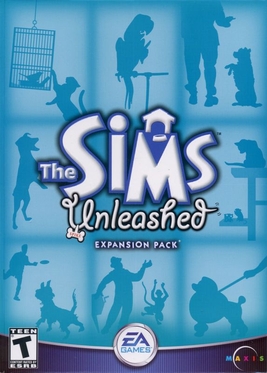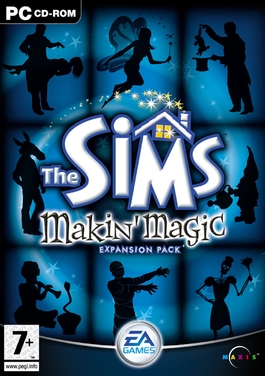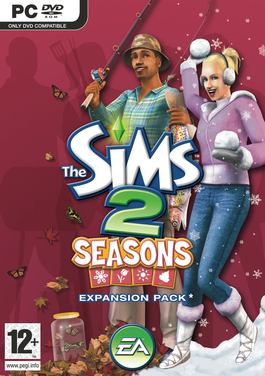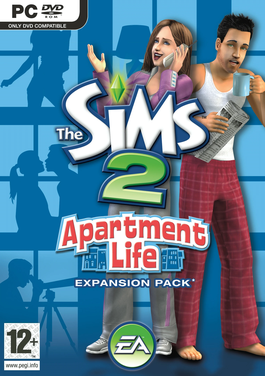
The Sims is a social simulation video game developed by Maxis and published by Electronic Arts in 2000. The game allows players to create and control virtual people, called "Sims", and manage their daily lives in a suburban setting. The game features an open-ended gameplay, where players can choose their own goals and objectives, and customize their Sims' appearance, personality, skills, relationships, and environment. A series of expansion packs were also released that add new content and features to the game, such as new careers, items, locations, and scenarios.

SimCity 4 is a city-building simulation computer game developed by Maxis, a subsidiary of Electronic Arts. The game was released in January 2003 for Microsoft Windows and in June 2003 for Mac OS X. It is the fourth major installment in the SimCity series. SimCity 4 has a single expansion pack called Rush Hour which adds features to the game. SimCity 4: Deluxe Edition contained the original game and Rush Hour combined as a single product.

The Sims 2 is a 2004 strategic life simulation video game developed by Maxis and published by Electronic Arts. It is the second major title in The Sims series, and is the sequel to The Sims. The game was released for Microsoft Windows on September 14, 2004, and a port for MacOS by Aspyr was released on June 17, 2005. Eight expansion packs and nine "stuff packs" were subsequently released between 2005 and 2008. In addition, versions of The Sims 2 were released on various video game consoles, including the PlayStation 2, Xbox, Nintendo DS, and GameCube, and mobile platforms, including the Nokia Ovi Store. The three handheld versions of the game are completely different among themselves, unlike the home console versions of the game, which are virtually identical to each other. All three handheld versions take on more of a linear storyline. A sequel, The Sims 3, was released in June 2009

The Sims: Unleashed is a 2002 expansion pack developed by Maxis and published by Electronic Arts for The Sims. The fifth expansion pack for The Sims, Unleashed expands the game's neighborhood to include a community area named Old Town which allows players to purchase pets, including cats and dogs, and farm their own produce. Unleashed was announced by Electronic Arts in June 2002 and released in September, with a Macintosh port of the game published by Aspyr Media in December. Upon release, Unleashed received generally positive reviews from critics, with praise directed to the scope and variety of the gameplay additions in the new neighborhood and pet mechanics, although expressing disappointment at the limited degree of control and gameplay mechanics involving pets. The concept of owning pets would be later re-introduced in The Sims 2: Pets, The Sims 3: Pets and The Sims 4: Cats & Dogs.

The Sims: Makin' Magic is a 2003 expansion pack for The Sims developed by Maxis and published by Electronic Arts. The expansion introduces magic to the game, featuring items that allows Sims to create and use spells, charms, and potions. The pack also introduces the Magic Town neighborhood, as well as Magic Town lots, which house vendors of magical ingredients and items and a number of magic-related mini-games. The game was the last expansion released for The Sims prior to the 2004 release of The Sims 2, with previews for the game included in the expansion. Upon release, Makin' Magic received generally favorable reviews from critics, with reviewers praising the novelty and depth of the magic mechanics and the Magic Town neighborhood, with some critiquing the expansion's difficulty and conceptual incompatibility compared to other aspects of the game. The expansion has received praise following its release, leading a pattern of magic-themed expansions in succeeding Sims titles including The Sims 2: Apartment Life, The Sims 3: Supernatural and The Sims 4: Realm of Magic.

The Sims: Hot Date is a 2001 expansion pack for The Sims developed by Maxis and published by Electronic Arts. The expansion adds a new community area to the game, Downtown, and provides players with more opportunities for their Sims to interact and romance one another. Upon release, Hot Date received generally favorable reviews, with praise directed to the game's expansion of game mechanics and locations in contrast to earlier expansions, although with some criticism of the limited options for customisation and the level of challenge with relationship management. Following release, Hot Date was a commercial success, becoming one of the top ten highest-selling computer games of 2001 and 2002 in the United States.

The Sims 2: Seasons is an expansion pack for the 2004 life simulation video game The Sims 2, developed by Maxis and published by Electronic Arts. The fifth expansion pack for the game, it was released 1 March 2007. Seasons introduces weather and seasons to the game, as well as new gameplay features such as gardening, fishing, and supernatural human-plant hybrids known as PlantSims.

The Sims 3 is a 2009 life simulation video game developed by the Redwood Shores studio of Maxis, and published by Electronic Arts. Part of The Sims series, it is the sequel to The Sims 2. It was released on June 2, 2009, for Mac OS X, Microsoft Windows, and smartphone versions. Console versions were released for PlayStation 3, Xbox 360, and Nintendo DS in October 2010 and a month later for Wii. The Windows Phone version was released on October 15, 2010. A Nintendo 3DS version, released on March 27, 2011, was one of the platform's launch titles.

SimCity 4: Rush Hour is the expansion pack for SimCity 4 created by EA Games and Maxis, where the player builds a city from scratch. It was released on September 22, 2003, simultaneously with a deluxe edition of SimCity 4 which also contains the expansion pack built-in.

The Sims 2: Bon Voyage is an expansion pack for the 2004 life simulation video game The Sims 2, developed by Maxis and published by Electronic Arts. The sixth expansion pack for the game, it was released 4 September 2007. Bon Voyage adds the ability to book in-game holiday travel to one of three pre-defined destinations, broadly themed around the Far East, Polynesia, and a generic mountainous region respectively. Each destination has its own unique culture, activities, and attractions. Other features of Bon Voyage include its expansion of the in-game inventory function, a number of new items and interactions, and its soundtrack, featuring Bob Marley's son Damian Marley.

The Sims 2: FreeTime is an expansion pack for the 2004 life simulation video game The Sims 2, developed by Maxis and published by Electronic Arts. The seventh expansion pack for the game, it was released 26 February 2008. The expansion pack introduces hobbies as a new feature for sims to pursue; sims can pursue ten possible hobbies and gain enthusiasm and benefits as they advance in them. The expansion pack also revamps the aspiration system, a system introduced in the base game that influences sims' long- and short-term goals.

The Sims is a series of life simulation video games developed by Maxis and published by Electronic Arts. The franchise has sold nearly 200 million copies worldwide, and is one of the best-selling video game series of all time. It is also part of the larger Sim series, started by SimCity in 1989.

The Sims 2: Apartment Life is an expansion pack for the 2004 life simulation video game The Sims 2, developed by Maxis and published by Electronic Arts. The eighth and final expansion pack for the game, it was released 27 August 2008. Apartment Life is a broad-concept expansion pack introducing various features, including the option for sims to live in apartments, a system of social class and personal reputation, a new pre-made neighbourhood, and a magic system in which sims can become witches and learn spells.

The Sims 4 is a free-to-play social simulation game developed by Maxis and published by Electronic Arts. It is the fourth major title in The Sims series, following The Sims 3 (2009). The game was released in North America on September 2, 2014, for Windows, an OS X version was released in February 2015, and PlayStation 4 and Xbox One versions were released in November 2017. The game was moved to a free-to-play model on October 18, 2022, monetized by the purchase of various paid downloadable content packs that have been developed since its release.
Twelve downloadable content "game packs" have been released for the 2014 life simulation video game The Sims 4, the fourth major title in The Sims series. All game packs are developed by Maxis and published by Electronic Arts, for the Microsoft Windows, macOS, PlayStation 4 and Xbox platforms. Game packs are intended to be smaller than full expansion packs. The first game pack, Outdoor Retreat, was released on January 13, 2015. The most recent game pack, Werewolves, was released on June 16, 2022.
Eleven expansion packs were released for the 2009 life simulation video game The Sims 3, the third major title in The Sims series. Of the eleven expansion packs, seven were developed by Maxis Redwood Shores, while the other four were developed by EA Salt Lake. All expansion packs were published by Electronic Arts. Expansion packs tend to focus on major new features, with the addition of many new objects, worlds, and game features geared towards the pack's major theme. The first expansion pack, World Adventures, was released on November 18, 2009. The last expansion pack, Into the Future, was released on October 22, 2013.
Seven expansion packs were released for the 2000 life simulation video game The Sims, the first major title in The Sims series. All expansion packs were developed by Maxis for Microsoft Windows and Mac OS X. Windows versions were published by Electronic Arts, and Mac OS X versions were published by Aspyr. Expansion packs tend to focus on major new features, with many objects, clothes, styles, worlds and life states are geared towards the pack's major theme. The first expansion pack, Livin' Large, was released on August 29, 2000. The last expansion pack, Makin' Magic, was released on October 29, 2003.

The Sims 2: University is an expansion pack for the 2004 life simulation video game The Sims 2, developed by Maxis and published by Electronic Arts. The first expansion pack for the game, it was released 1 March 2005. University introduces a new "young adult" life stage who live in separate college towns and attend university; with its dormitories, the expansion pack marks the first time in the Sims series where player sims are able to live with non-player characters. Sims who attend university gain access to new careers and interactions. University also introduces new items, interactions, and gameplay elements, such as the ability to bring deceased sims back to life, the ability to play musical instruments and use mobile phones, and the ability to turn sims into zombies.

The Sims 2: Open for Business is an expansion pack for the 2004 life simulation video game The Sims 2, developed by Maxis and published by Electronic Arts. It was released 2 March 2006 as the third expansion pack for the game. Open for Business adds tycoon elements to the base game, allowing sims to run businesses from their homes or community lots. Multiple new advancement systems are added, such as talent badges, which track sims' progress in business skills; business ranks, which measure a business's success based on its company loyalty; and business perks, gifts or skills granted to a sim for running a successful business. The expansion pack also expands upon elements introduced by previous expansions, such as restaurants and romantic chemistry, and expands the base game's building options.

The Sims 2: Pets is an installment in the life simulation video game series The Sims. It was released as an expansion pack for The Sims 2 on Microsoft Windows and Mac OS X, while it was released as a stand-alone title on consoles. All versions were developed by Maxis and published by Electronic Arts on 17 October 2006. The expansion pack adds domestic animals to the game, allowing sims to own cats, dogs, and other species. Players can customize the appearance and personality of their pets, which are able to learn tricks and work jobs. The stand-alone console games maintained the open-ended sandbox gameplay of the series; the handheld versions had more structure, including role-playing video game elements.


















